We know that hybrid events are going to be a mainstream type of event now and for the foreseeable future, so it makes sense for you to know everything about hybrid events. From basics of hybrid events to best practices and even pros and cons. Without further ado, let’s deep dive into understanding the ins and outs of hybrid events.
Give us about five minutes and you will be a pro at hybrid events.
What Are Hybrid Events?
A hybrid event mixes both physical and virtual event elements for a complete and accessible experience, regardless of location and physical presence. Hybrid events are extremely convenient to attend, and get much more engagement than physical events.
If you’ve hosted a physical event before, you know what it takes to bring together exhibitors, attendees, and industry experts to the same place at the same time. You need considerable time and resources to successfully host an in-person event. Virtual events are easier to host but may dampen the experience for people who are in the area and would like to attend your event in person. The hybrid model makes everyone happy and comes equipped with numerous other benefits as well.
Types of Hybrid Events
Light Hybrid
In a light hybrid, the event is happening at a physical venue with a virtual audience in parallel. The integrated touchpoints for a lite hybrid event all take place during the presentation. For example, physical attendees attend the seminar while live stream is shown to the virtual audience. Q&A participation can also be done by the physical audience and virtual participants via chatbox or social media.
Sequential Hybrid
In a sequential hybrid event, the physical event happens at a different time as the virtual event. Even though they take place at different times, the sponsorships, content, exhibitors can be the same. Here there isn’t any cross-networking involved across audiences during the event, to keep things simple. However, a mobile app may facilitate physical event networking.
Complex Hybrid
This is very easily deemed as the future of hybrid events and one which is the most popular. The complex hybrid event allows the physical and virtual events to happen at the same time. The sponsors, exhibitors and content are the same. There are multiple cross-networking touchpoints enabled through the mobile app including chat, polls, Q&A discussion boards, matchmaking across audiences, etc. In some complex hybrid events, there might even be check-in technology and screen technology available.
As discussed above, there are multiple ways physical and virtual events come together. We call them the ‘dimensions of hybrid events’. Let’s see what that means.
Dimensions of Hybrid Events
Hybrid events are flexible, we have already established that. Their flexibility ranges across five dimensions:
- Time
- Audience
- Exhibitors
- Networking
- Content
Let’s understand how each of these dimensions allows the organizer to put together a hybrid event that suits their needs and hence grants them flexibility.
1. Time
When hosting a hybrid event, bringing together audiences in a physical space and attracting participants virtually means the event can be flexible in terms of the timings. Catering to the different time zones is where hybrid events shine. They don’t limit or restrict their audience, hence the increased reach.
Both the physical and virtual audiences can be participating and in attendance at the same time. However, it doesn’t always have to be parallel i.e. your physical and virtual events don’t have to run at the same time. They can run at various different times, and even for a different number of days. This particular type of event is called ‘hybrid sequential’. Where physical and virtual events are not necessarily running simultaneously.
2. Audience
The audience for your two events, again, can be different or the same. Your attendees who are present at the physical venue can be given access to the virtual event for additional information, features, virtual webinar sessions and engagement activities such as scavenger hunts etc. Hence, the audience is the same.
On the other hand, you can also have a completely different set of audiences for your two events. This would mean different content, activities and sessions for the two audiences based on their requirements.
An example of having two sets of audiences is clear in Apple launch events. They usually have a live audience and then their event is live-streamed to millions of viewers across the globe who are in different time zones themselves. The audience gets the same content, they see the entire event.
3. Exhibitors
Just as with your attendees, you can also host a different set of exhibitors at your physical and virtual venues. Your exhibitors might want to have their booths in the physical location itself if they feel that is where their target audience lies. On the other hand, some might only want their booths in the virtual space.
However, some might want their booths in both venues to capture a wider set of audience, and to extend their reach.
Almost all of the exhibitors at the BerniePortal Hybrid Conference were at both the virtual and hybrid events. It is completely up to the host and/or exhibitors whether they want to be present at both events, or just one.
4. Networking
Just as the other dimensions, hybrid events offer absolute flexibility when it comes to networking. When we say networking in a hybrid event, we’re referring to how the two different audiences will be interacting with one another — if at all. As the organizer, you might not want them to interact with each other depending on your goals. However, it is completely possible.
Interacting in real-time, your virtual audience could interact with the virtual audience only. The physical audience can engage with the physical audience. However, the two separate audiences can interact with one another as well. The physical audience with the virtual and vice versa. Through chat tools and cross-platform breakout sessions, this is possible.
This again is dependent on what the organizer wants to achieve with their hybrid event.
5. Content
How the organizer and exhibitors play out the content can also be completely different across the medium. They can even be the same across the medium. For example, the physical audience might have access to special webinar sessions. These could be VIP sessions.
Whereas the virtual audience might be able to participate in scavenger hunts, trivia or interactive Q& sessions to interact with the speakers and fellow attendees. The virtual audience might have content available to them which is not easily available to the physical audience. They might even be able to download the content or email it to themselves via the swag bag, something which the onsite attendees cannot do unless they have access to the virtual event.
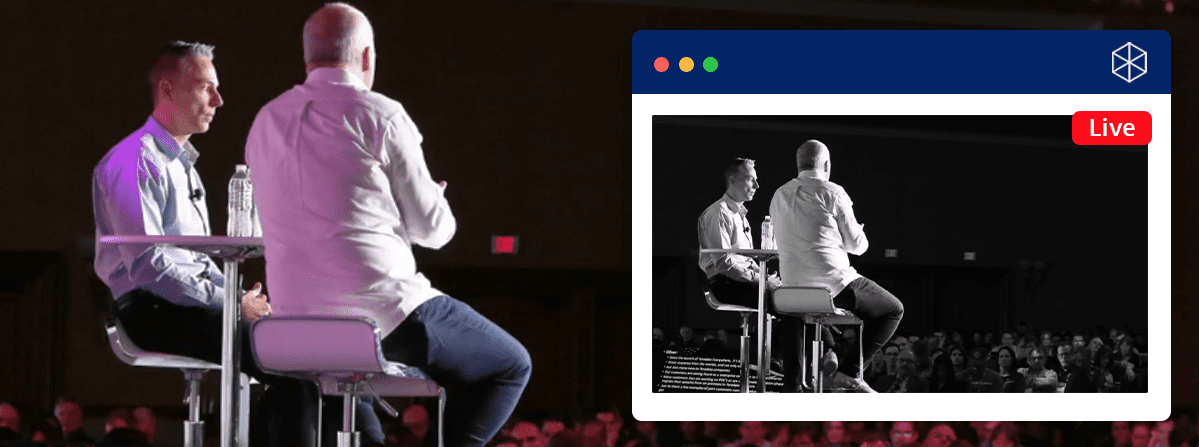
What Are The Benefits Of Hybrid Events?
Hybrid events offer a lot of benefits to all parties involved. Whether you’re an organizer, exhibitor or simply an attendee, you stand to gain significantly from such a conference. Its benefits range from convenience to post-event metrics, and much more.
Increase Your Reach With Hybrid Events
Going back to physical events after a long period of time will be quite overwhelming for many people. This is because numerous people are still following COVID-19 precautions or may simply not be able to travel. Furthermore, it is difficult to take out time and resources to attend an event in another city or country especially when a viable alternative allows them the same exposure and benefits.
Hybrid events are the perfect solution for this problem. They can help increase your reach immensely, as you won’t be limited to just your physical audience. You can attract people from all across the globe to participate in your event from the comfort of their homes.
Attract High-Profile Speakers
As is the case with participants, speakers may also find it difficult to take time out to talk at a physical event. They need to commit a considerable amount of time to travel to a venue and just speak for an hour or so on a panel. This commitment may make high-profile speakers miss your event if it’s completely in-person.
However, if you host hybrid events, the speakers who can make it will come, while the rest will be able to take time out to participate online. This requires much less commitment, and you’ll be able to attract high-profile speakers. These speakers, in turn, will pull in a larger audience, both physical and virtual.
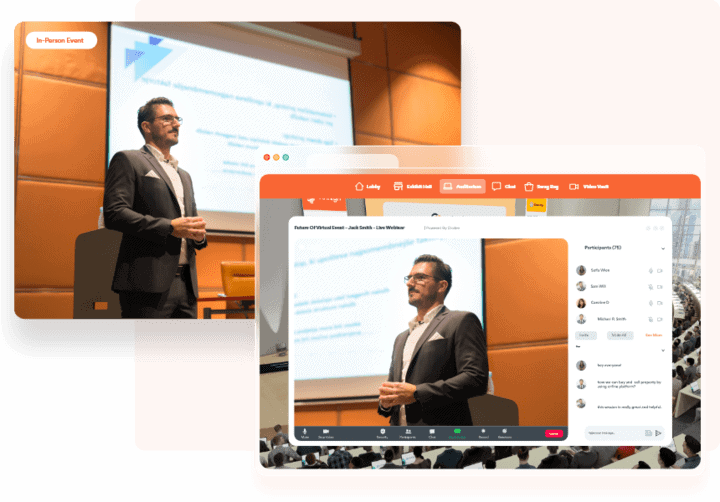
Offer A Positive User Experience
While both physical and virtual events have their own set of benefits and fun features, hybrid event software offers the best of both worlds. The virtual environment is easy to navigate and attempts to emulate the physical experience as much as possible. In the meanwhile, it has its own outstanding features such as 3D event halls, replayable webinars, networking chat rooms and a host of other facilities.
This lets both on-site and virtual visitors enjoy the event to its fullest, without compromising on convenience. This positive user experience makes hybrid events well worth it.
Provide Extensive Insights For Hybrid Events
When it comes to hybrid events, hosts and booth owners can easily track visitor attendance and engagement insights. The event will record every user interaction, and help companies measure ROI.
These insights are quite valuable, as they can help you get sponsors on board as well. In fact, some companies may even be willing to pay for this in-depth data! In a time where data is everything, you’ll be able to gather precious information. Companies can use this information to gauge their marketing and sales efforts and hosts can use it to plan better events next time.
Knowing the benefits is enough to jump into hosting a hybrid event. But leave no stone unturned when researching for your event. We’ve listed down some must-ask questions, which you must consider before making the final decision.
Questions to Ask Before Planning a Hybrid Event
Here are some top questions to ask during the planning stage of your hybrid conference:
1. Is a Hybrid Event Different from a Virtual Event?
Unlike a pure virtual event, that takes place online exclusively having a virtual audience, a hybrid event also includes in-person attendees along with the virtual ones.
2. How Do You Staff a Hybrid Conference?
A hybrid conference mostly requires even more staffing adjustments as compared to virtual events. This is to ensure that attendees enjoy a worthwhile experience, whether they join in person or online.
There are several key roles to consider when making your hybrid events team. Some of the common examples include an event technologist on the virtual side to help select the right technology, and an executive producer to ensure all the virtual aspects of your event are running smoothly. As for the in-person event team, an onsite technician must be hired to check on microphones and internet connections, and a speaking coach will be responsible for helping your presenters communicate to both audiences effectively.
3. How Will a Hybrid Conference Benefit Me?
A hybrid event is usually defined as a natural step for event organizers who wish to move forward towards the old live events routine but face government restrictions. Even participants sometimes are hesitant to travel and gather in groups due to the pandemic.
Also, hybrid conferences offer some additional unique advantages such as cost-effectiveness, unlimited scalability, increased reach, better audience insights, improved ROI, valuable data collection, and a powerful unified message that can reach people globally.
4. What Sort of Technology is Needed in a Hybrid Event?
You need better technology when it comes to increased production considerations. Some important technical aspects to consider are:
- Having live event support at a broadcast level.
- A minimum of one professional camera per room, along with a good quality sound recording.
- Consider having multiple camera angles in the room for a truly high-quality stream.
- A hybrid event platform offering Interactive features for in-person as well as remote attendees to engage in a better way.
- A virtual event platform where attendees will learn about and access the content presented in your event. Also, a place to host recordings after the event is done.
5. What Challenges Will I Face in Hybrid Event Management?
Virtual and live audiences are two different bodies having many different needs. In order to create a unified event experience for both, you’ll need to account for both of the audiences’ needs. Here are some important considerations:
- How to adapt content and create a digital experience that will keep your virtual audience as well as your in-person audience engaged?
- Is there any need for additional moderators for the purpose of facilitating discussions with the online audience?
- Are you ready to invest in the additional health and safety resources that will enable your live audience to meet physically, face-to-face?
- With social distancing still surrounding us, how will you create an in-person experience to make live participants feel more special?
6. Who is Going to be My Audience?
When planning for a hybrid conference, you will never want to make assumptions. However, the profession and age of your audience may affect your in-person turn-out. Make sure if you go ahead with a hybrid event, you understand what your audience’s expectations are and what they hope to get out of both the physical and virtual events respectively. After all, the event is for the audience, and delivering an event they consider memorable is the end goal.
7. What Type of Venue is Suitable for Hybrid Conferences?
Some of the top event spaces like hotels, that made better sense pre-pandemic, might no longer have space. Nor amenities to fulfill your needs. Although minimum spends might still be there, despite the fact, a small fraction of attendees might safely be able to attend the hybrid conference.
On the other hand, hybrid events bring new opportunities. You can seek out new spaces that lack added costs such as food and rentals. You’ll want to consider venues that offer built-in new tech and fulfill production needs. You can also consider a partnership with a brand that owns existing hybrid infrastructure already in place. You can avail this in exchange for some branding control.

8. Are Marketing Strategies Different For a Hybrid Event as Compared to Face-to-Face Event?
You’ll utilize the same channels that are best to market live events, to market hybrid events. The channels include social media, email marketing, paid advertising, content marketing, etc.
The only difference is the timing of your marketing efforts for hybrid events. At vFairs, as we’ve greatly helped our clients switch to virtual events, they’ve seen a dramatic increase in registration numbers the week before their event. This is a completely different trend as compared to what planners typically see with in-person events. In order to maximize your online audience, it is essential that you increase your marketing efforts. You need to do this the week before your hybrid event takes place.
9 Questions to Ask Your Hybrid Event Vendors
Believe it or not, virtual and hybrid events are on the verge of transforming into the new norm. That being said, they are not only easily manageable but convenient for both hosts and attendees. The market is inundated with the flow of software, which resulted in the quality dripping down the drain. A year ago, companies had only a few handful of options to select from. Now they’re exposed to a whole list of companies offering hybrid event software.
The only salvation now, lies in interrogation. Ask the following questions when looking for a hybrid event software for your event.
1. How Can Your Solution Help Me Accomplish My Goals?
Events, virtual or otherwise, should be used as a part of a larger strategy. The first step, then, is to understand how a hybrid event will help you achieve your marketing/HR/recruiting goals.
Various types of events (conferences, trade shows, career fairs, etc.) can be hosted in a hybrid setting. Having an idea of all these will allow you to understand which format aligns best with your business goals. For example, you’ll want to host a hybrid career fair if you’re on a talent hunt. Or a hybrid product trade show will suit you best when launching your new product in the market.
Having an agenda, an idea of why you want to conduct the event in the first place will allow you to decide on the hybrid event software. When looking for hybrid event software, you’ll first look at its features. Thus goals feed into needs that eventually determine the features you want in your event platform.
2. To What Degree Can We Expect Customer Support?
You don’t want to find yourself struggling to diagnose and/or troubleshoot a problem during the event. Software is prone to technical issues and glitches, but shouldn’t disrupt your event or cause your remote attendees any inconvenience.
That is why you should always ask if your company will be entertained with technical and event setup support.
Technical support does not only mean offering solutions in times of crisis. It should also include support to connect the virtual and physical event and offer all necessary technical requirements. So, you should look for a company that is proactive and can take care of all those needs directly with the venue or AV provider.
Event setup support is crucial, especially if you’re just getting into virtual events. Your hybrid event software provider should offer a dedicated team of experienced professionals to help with setup and handhold as much as needed throughout the whole process-on both the physical and virtual fronts.
Stepping into novel grounds can be intimidating, but having a team of helpful professionals by your side can help minimize errors and offer effective solutions to any problem that might arise.
3. How Much Control Do We Have Over The Interface?
Customization is paramount to hosting virtual and hybrid events as it allows companies to represent their brand instead of going with a generic interface. You want your remote attendees to have a sense of your company through your interface.
Find a company that allows you to design lobbies, conference rooms, etc. for your event so that even your remote attendees get to experience the event rather than feeling as if they’re taking an online lecture or navigating through a flat webpage. These designs can be customized according to your brand needs, the venue layout, and nice-to-haves like integrations and fun features. You can even design virtual booth representative and receptionist personas based on what your company represents.
4. How User-Friendly Is The Platform?
Complex UI is such a fiasco. You need a hybrid event software that realizes that and offers a user-friendly interface. The design should be such that people feel comfortable ‘entering’ the virtual space and navigating around. It should be built to feel as intuitive as walking through the in-person event.
Try not to overdo it when it comes to designing the layout. Aesthetics have an important role, but remember the simpler, the better.
5. What Metrics Can I Track?
Briefly discussed above, you must not take the analytics data for granted because these are the parameters you’re going to utilize to make shrewd calculated decisions.
Way back, it never dawned upon the organizers to consider this feature. But today, it’s a must because the more you analyze the behavior of your attendees, the better you’d be in a position to understand the psychology behind doing what they do. Thus, allowing you to create personalized and segregated follow-up strategies to increase your lead conversions.
A good hybrid event software will offer a variety of metrics to help determine ROI, these include:
- Attendance Data: To be gathered from logins to the event. Since a portion of your audience is in-person, having people sign in through QR codes and reconciling the two will offer you the required attendance data.
- Traffic: This includes webinar attendance, booth attendance, most/least popular spaces within the virtual venue etc. If you host all event collateral virtually, you’ll get traffic data from in-person attendees, as well. Offering a much accurate estimate.
- User Engagement: Includes chat metrics, participation in games such as scavenger hunts, participation in polling, trivia and Q&As, document downloads, etc.
- Individual User Activity: Tracking how individuals navigated through the virtual venue. Also offers insights into trends of in-person attendees.
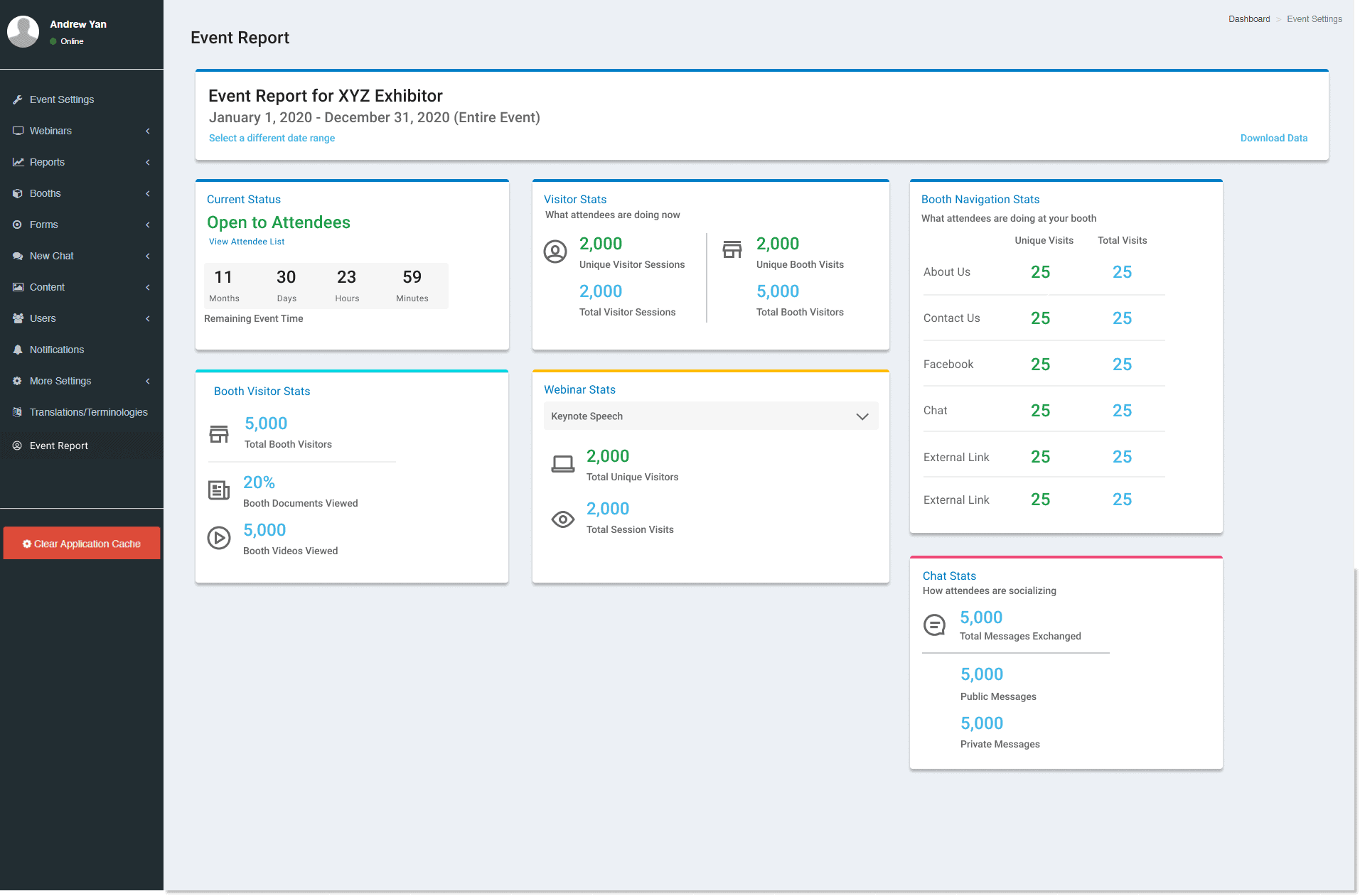
6. What Is The Allowed Number Of Attendees?
Will you be able to host a certain number of attendees through the hybrid event software?
You want to know if there’s any limit to the number of attendees you can invite, to avoid any issues during the event. You need to ensure that both the software and physical venue you’re going with support your anticipated number of remote and in-person attendees, respectively.
In short, your virtual and in-person ticket caps should reflect the hybrid software and physical venue capacities, respectively.
7. Can I Localize My Meeting Language?
That’s a genuine concern for the companies hosting hybrid events. With a global audience as your attendees, how are you supposed to cope with that?
Apart from the issues faced by networking via the internet, language is another barrier to cross to conduct a well-managed event where everyone has the opportunity to convey his stance on a subject; that’s most probably a focal point of such a composite event. While on-site events can post signage in multiple languages, you need to make sure your virtual portion could offer multilingual signage options throughout the venue.
Additionally, your hybrid event software can add a layer of accessibility to it by integrating with tools like KUDO, Interprefy, Wordly, and SyncWords. Each of these offer your attendees the option to experience live webinars in their language of choice.
8. Can I Join The Meeting From A Mobile Phone?
How often do you use your phone? A recent survey examined that there are 3.5 billion mobile phone users worldwide. An average American spends almost 3 hours of his day on the phone, which confers a substantial weightage.
While some hybrid event software offers a mobile application, it’s easier for attendees to simply access a mobile-friendly event from their mobile browsers. No need to download anything to participate, just click the URL and you’re in the event.
9. Do You Offer A Free Demo?
The industry is already dealing with cutthroat competition as new suppliers are diving in to maximize their returns. You, as a buyer, stand a chance to relish this opportunity and select from a long list of options lying before you.
To know if the software is compatible with all your needs, you must not risk it and ask for a free demo before anything. Not only you’d be in a position to get hands-on experience on the end-product, but you’d be in a better position to decide.
Hybrid Events Best Practices
Due to a difference in the setting, there’s a gap in the experience your remote and in-person audiences will have. Your job, as a host, is to minimize this gap to provide a seamless, interactive event for both audiences.
To help you achieve that, here are our top hybrid event best practices to counter this issue and host an ideal hybrid event.
1. Keep Yourself Open To Revisions
To avoid last-minute panic, this practice can help you a great deal. If the content to be delivered is decided, and the speakers are assigned their topics, you must re-visit the presentations, videos, and all that content to be presented before the audience.
See if it aligns with your agenda for the event and provides value.
You need to serve the participants with value-added content for their invested time in your event. And if that means revisiting your content a few times over, it’s worth the effort.
However, as an event planner, you should approach your first hybrid event as a learning opportunity. There will be a trial period for all companies as they shift into this new way of hosting events.
Our clients have shared similar concerns when they started hosting virtual events: they were intimidated at the idea of it because they’ve never done it before. But the more events they hosted, the better they became at it.
2. Adhere To On-Site Operation Functionalities
It’s not that big of a concern for the virtual delegates but the physically present participants; you’ve to rehearse where the show is supposed to happen. You, with all your team members, should schedule a specific time of the day to rehearse and examine if the lights/sound is functioning properly, so it doesn’t cause an embarrassment for you when actually, you’d be there.
Additionally, make sure that anything being live-streamed is set up so that it offers clear audio and video to the virtual audience. Do a quick ‘tech check’ before the event, where someone can view the presentation through the virtual platform and suggest any changes if needed.
3. Engage The Virtual Partakers
It’s easier for remote attendees to just sit back and attend the event passively, without actively taking part in the event. Being the host, you should not let this happen.
To better engage your remote audience, instruct your speakers to address queries, comments and suggestions sent in by virtual attendees. The involvement from the on-site attendees is undoubtedly essential. But most of the time, they manage to interact as the speaker is right in front of them, unlike the participants who joined the session remotely.
At live webinars, it is crucial to engage both audiences. Use features that both in-person and virtual attendees can interact with. For example, live polling and Q&As can be conducted through the virtual platform app by both remote and in-person attendees. This will also allow organizers to gather event analytics once the event is over.
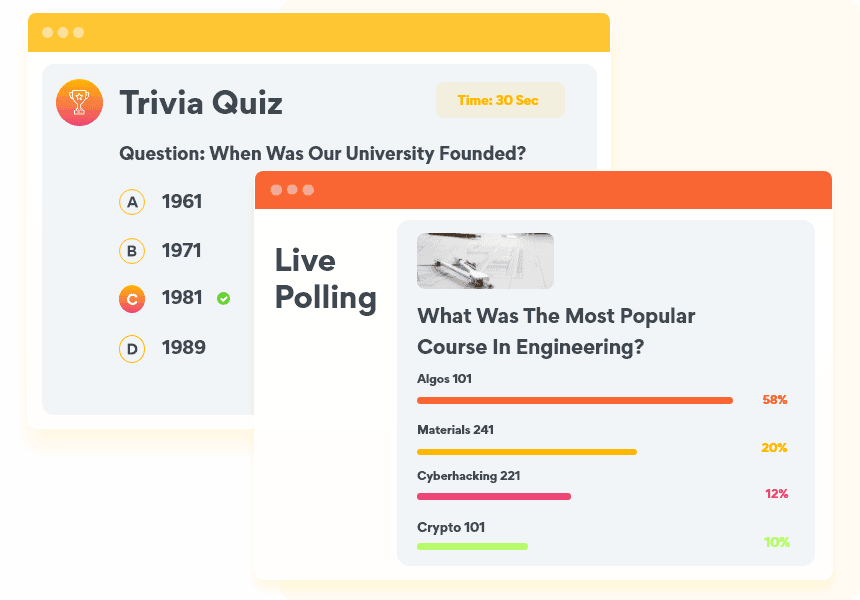
4. Set Time As Your Priority
Audience attention spans have reduced drastically and a slight sluggishness might cost you a fortune. Especially those who’ve joined remotely are more prone to being victimized.
Schedule your event so that the sessions are not too long and there are breaks in between. But keeping short sessions does not guarantee engagement, you’ve got to provide value-added content in an interactive way.
You should also consider time zones for people who are attending virtually. If there is a large audience from around the world, it would be best to stream the in-person presentation, and then also upload a recording of it for others to see on their own time.
5. Consider The Capacity For Attendees
Organizers should set a cap for the number of in-person tickets they sell.
If in-person tickets sell out, you should make an extra effort to promote the benefits of going to the virtual event. Some people may not buy tickets if they can’t attend in person because they don’t see value in the virtual event. This is where your marketing team needs to step in to address their concerns and explain why the virtual alternative is worth the purchase.
6. Foster Networking Opportunities
Networking is one of the top reasons why people attend business events. Your job is to make sure that the audience that’s in your hybrid webinar/meeting interacts effectively. Providing networking opportunities to a hybrid audience is a bit tricky since a portion of your audience is present while the rest is attending it remotely.
Also, encourage attendees to set up user profiles on the virtual event platform, regardless of whether they’re joining the virtual or physical event. This way attendees and exhibitors can easily search profiles and start conversations with key targets. They can also request meetings with each other. Even if they’re both in person, it would help them better manage their calendars.
vFairs with its hybrid event software makes networking easier by allowing participants to interact via the 1:1 chat, text, or even video calls.
7. Take Economic Feasibility Into Account
This aspect is often ignored despite being one of the most crucial elements in setting up a hybrid event.
Some of the cost factors are enlisted down here:
- Virtual venue cost
- Venue booking
- Production and A/V costs
- Internet connectivity cost
- Catering/food and beverage for on-site attendees
- Setup and teardown crew
- Travel and accommodations for hosts and speakers (if you’re covering those costs)
These costs, when compiled, might turn into a considerable sum, sometimes costing hundreds of thousands of dollars, depending on the event needs. So, it’s better to be prepared and have reasonably accurate estimates of the capital required.
Budgets should take into consideration the amount of money you, the event host, could stand to recoup from sponsorships and tickets. If you expect a high return on investment, you may be able to justify spending more upfront. If you’re in an industry where there is some skepticism about hybrid events, it may be more prudent to consider starting small and slowly gain buy-in from more sponsors and attendees over time.
8. Perform Analysis To Measure Success
Analyze what’s working out for your business. Events are not a one-time thing and it’s important to learn from the issues of your previous event/s.
Sadly, audience applause is not an accurate measure of an event’s success. It’s better to trust the numbers since It’s the analysis of parameters that represent if the event was a success or not.
You need to interpret event analytics and reports and make decisions based on these results for better events (in terms of engagement, ROI, lead generations, etc.) in the future. Virtual event managers help you generate and interpret these event reports.
Here are best event practices for more accurate event data collection:
- Registration and attendance rates are automatically tracked through attendee logins to the virtual venue. However, for in-person attendance, you could sign people in using QR codes. And migrate that data to show more accurate attendance of both virtual and in-person attendees.
- Booth traffic is mostly tracked for virtual attendees. But if you follow our best practices from above and host all event collateral virtually, you can track the most popular content downloads, etc. which gives us a good idea about how in-person booths performed, too.
- Chat metrics at hybrid events can be tracked for both remote and in-person audiences if you get all attendees-virtual and in-person-to fill out user profiles. They’ll be more likely, thus, to use the virtual chat function to interact with each other.
- Presentation engagement can be measured by integrating interactive features such as polling and Q&A (as mentioned before).
- User journeys can be tracked exclusively for virtual attendees. However, these user trends may offer valuable insights into how in-person attendees navigated the event, too. That is more likely if the virtual venue mirrors the in-person venue.
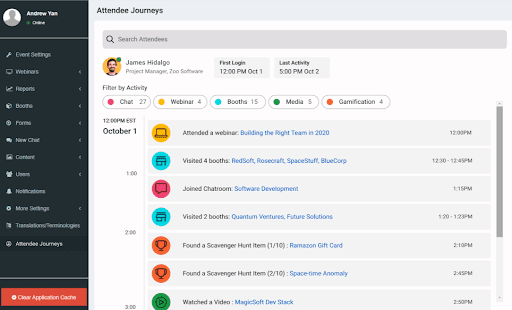
There you have it, a small all you need to know about hybrid events put together. Lastly, we want to quickly take you through some pros and cons of hybrid events.
Hybrid Event – Pros
- Increased attendance capability
- Eco-friendly – they have a reduced impact on the environment
- Powerful sponsor opportunities
- Higher audience engagement
- Valuable data and insights into attendee behavior
Hybrid Event – Cons
- Hosting an in-person and virtual event simultaneously could be complex
- Sponsors may need extra guidance
- Additional coordination & engagement requirements
- Potential connectivity & technology issues
- Change is always challenging – convincing attendees, exhibitors, speakers and all other stakeholders about the benefits of hybrid events might be a difficult task
Final Thoughts on Hybrid Events
No matter what stage of planning you are in, hybrid events are a win-win situation. Such events offer all the possible advantages of an online event. This is perfectly accompanied by allowing attendees to have face-to-face interactions with the guests as well as deliver an exceptional event experience.
Talking about hybrid event’s pros and cons, it’s a unique experience. It can be incredibly valuable as well as rewarding if managed and hosted the right way. Ask your event provider the right questions, pay attention to detail when putting together your event, and be obsessed about bringing the best experience to your stakeholders and you’re set.
Ready to learn more about Hybrid Events?
Get your Ultimate Guide To Hybrid Events
Download My Hybrid Events Guide

